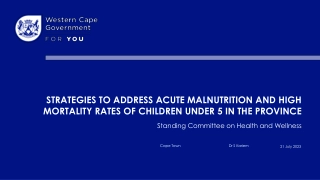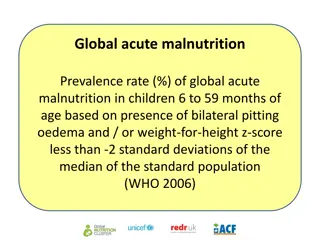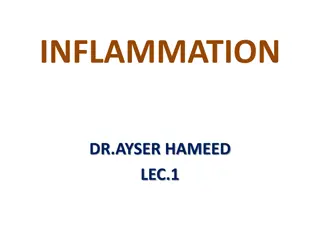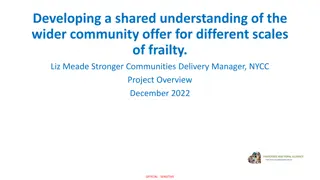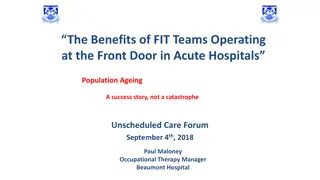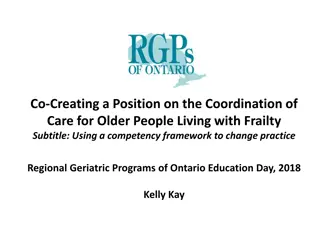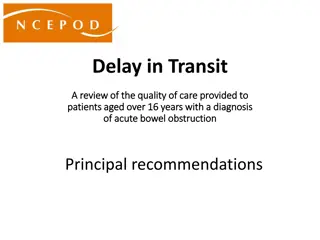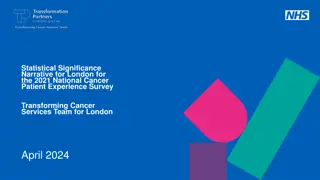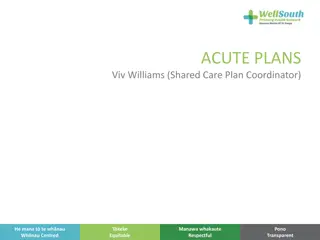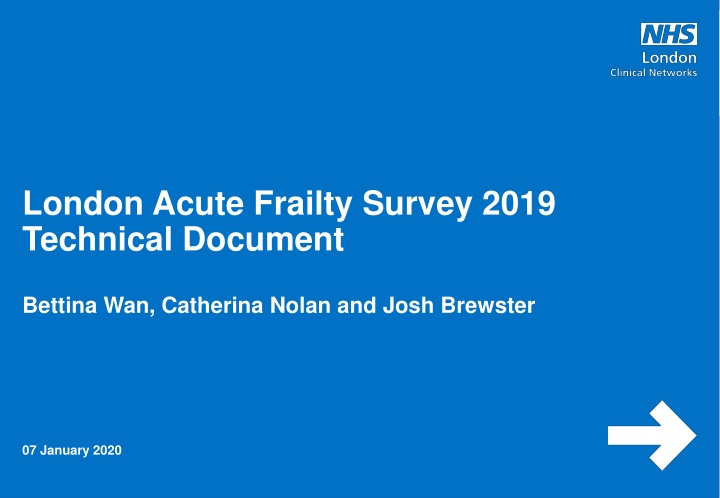
Insights into London Acute Frailty Survey 2019
Explore the findings from the London Acute Frailty Survey 2019, including details on response rates, service provision, team structures, and operational areas within the healthcare system. Discover key insights and trends shaping acute frailty services in London.
Download Presentation

Please find below an Image/Link to download the presentation.
The content on the website is provided AS IS for your information and personal use only. It may not be sold, licensed, or shared on other websites without obtaining consent from the author. If you encounter any issues during the download, it is possible that the publisher has removed the file from their server.
You are allowed to download the files provided on this website for personal or commercial use, subject to the condition that they are used lawfully. All files are the property of their respective owners.
The content on the website is provided AS IS for your information and personal use only. It may not be sold, licensed, or shared on other websites without obtaining consent from the author.
E N D
Presentation Transcript
London Acute Frailty Survey 2019 Technical Document Bettina Wan, Catherina Nolan and Josh Brewster 07 January 2020
Contents Acute Frailty Survey 2019 3 Response to Survey 4 Acute Frailty Service 5 The Frailty Team 7 Service Provision 9 Development of a frailty service 11 Acute Frailty Service Target 12 Barriers to Achieving the Target 13 Service Design and Screening 14 Screening Tool 15 Admittance and Discharge 17 Education and Training Provision 19 Education and Training Delivery 21 Advanced Clinical Practitioner (ACP) 26 Additional Comments 27
Acute Frailty Survey 2019 Acute frailty services are services that: Routinely and systematically screen people presenting acutely to the hospital for frailty* Respond to their personalised needs taking into account the level of frailty and degree of illness. Have a multi-disciplinary (frailty) team capable of assessing and managing frailty syndromes, initiate and complete where possible comprehensive geriatric assessment. Have clear reliable pathways into and out of hospitals *Screening may be done by any trained staff member who knows how to escalate to a frailty team The survey was sent to lead Geriatricians across London in sites with type 1 Emergency Departments. Data was collected from 23rdOctober to 13thDecember 2019.
Response to Survey 22 sites responded out of 26 (85%) All south London sites responded (9/9) 76% north London sites responded (13/17) Which part of London are you based in? South West London 18% North Central London 18% North Central London North East London North West London South East London South West London South East London 23% North East London 23% North West London 18%
Acute Frailty Service 18 (82%)*sites that responded have an acute frailty service Most (72%)+acute frailty services operate in the Emergency Department The median number of clinical areas the acute frailty services operate in is 3 The number acute frailty services operate in ranges from 1 to 4 clinical areas *Denominator of 22 which is the number of sites that responded to the survey +Denominator of 18 which is the number of sites that responded as having an acute frailty service at the time of response
Which areas does your acute frailty service operate in? 14 12 10 Number of Sites 8 6 4 2 0 Emergency Department Observation Ward/Short Stay Unit/Assessment Unit Specifically for LoS under 24 hours Other short stay unit including medical/surgical assessment units Ambulatory emergency care unit (AECU) Acute Frailty Unit Other Service Location *Other: Emergency Floor, TREAT Hub, All Wards, Frailty Unit
The Frailty Team The acute frailty team ranges from 2 disciplines up to 8 disciplines The median number of disciplines part of the team is 5 A Geriatrician is a part of all teams Only three team combinations occur more than once: oGeriatrician and Specialist Nurse (Twice) oGeriatrician, Occupational Therapist, Pharmacist, Physiotherapist and Specialist Nurse (Twice) oGeriatrician, Occupational Therapist, Pharmacist, Physiotherapist and Psychiatry liaison (Twice)
What disciplines form the team that provides the acute frailty service? 20 18 16 14 12 Number of Sites 10 8 6 4 2 0 Geriatrician Junior Doctors Nurse Occupational therapist Pharmacist Physiotherapist Psychiatry liaison Social worker Specialist nurse Other Professional Discipline *Other: Healthcare Assistant, Physicians Assistant, Rapid Response Team
Service Provision 5 (28%)* sites are currently providing an acute frailty service at least 70 hours per week 17 (94%)* sites provide a 5-day service 10 (56%)* sites provide a 6-day service 8 (44%)* sites provide a 7-day service Only sites providing 12 hours in the week are achieving > 70 hours The number of hours ranges from 84 to 37.5 per week *Denominator of 18 which is the number of sites that responded as having an acute frailty service at the time of response
Service Hours per Week 90 80 70 60 Number of Hours 50 40 30 20 10 0 D N T B G P V U F O C H I L Q R J A E K M S Site Weekday Saturday Sunday Mean Target
Development of a frailty service 4 out of 22 sites currently do not have an acute frailty service however they all plan to have one Only one of these sites is planning to have a 70-hour service by the end of December The site planning to achieve the target is currently running weekly frailty meetings and piloted an Emergency Department based frailty fortnight. Their challenge is that despite executive backing and a strong business case it was declined by the finance and business part of the trust. They are awaiting winter funding.
Acute Frailty Service Target By 31st December 2019, all trusts with type 1 Emergency Departments are expected to provide an acute frailty service for at least 70 hours per week Two sites currently providing an acute frailty service are intending to provide a 70-hour service by the deadline One site is planning to do this by increasing their weekday hours The other site is increasing cover on Saturday and extending the service to Sunday The main barriers noted were staffing, continuous funding of posts and a social worker only being present on either Saturday or Sunday
Barriers to Achieving the Target 18 (69%)* sites are not achieving the 70-hour target and have no intention of achieving it by 31st December 2019. The main barriers were: Funding Staffing Recruitment and skill mix, weekend cover Training Internal challenges on resource allocation Need Support - for business cases, information on Same Day Emergency Care and tariffs Two sites expect to achieve the target by February 2020 (bringing sites at target to 10 - 38%*) One site is expected by April 2020 (bringing sites at target to 11 - 42%*) *Denominator of 26 which is the total number of sites with a type 1 Emergency Department in London
Service Design and Screening 5 (28%)* sites have a single point of access which is simple, reliable and quick that provides them with all the support needed in the community to facilitate discharge 8 (44%)* screen for frailty, but only in defined age groups 6 (33%)* screen for 65+ and 2 (11%)* screen for 75+ 6 (33%)* only screen during the operating hours of the acute frailty service *Denominator of 18 which is the number of sites that responded as having an acute frailty service at the time of response
Screening Tool 8 sites (44%)* that have an acute frailty service responded that they use a specific tool for screening Screening is predominantly completed by a Specialist Nurse 6 (75%)+ use the Rockwood Clinical Frailty Scale (CFS) 6 (75%)+ use frailty identification to determine patient pathway 8 (100%)+ have a defined multi-professional assessment for patients identified as living with frailty In 9 (50%)* sites following the holistic assessment of a patient, a personalised problem list and frailty care plan is started (and completed where possible) to reflect the needs of the patient *Denominator of 18 which is the number of sites that responded as having an acute frailty service at the time of response +Denominator of 8 which is the number of sites that screen for frailty
Who is the screening typically completed by? 8 7 6 5 Number of Sites 4 3 2 1 0 ED Doctor ED Nurse Geriatrician Occupational therapist Professional Discipline Physiotherapist Specialist nurse Other *Other: Computerised Frailty Scale, Discharge Coordinator, Junior Doctor
Admittance and Discharge For admitted patients: 7 (32%)* sites have processes in place for continuity of delivering the frailty care plan on the acute frailty unit and healthcare for older people s ward For discharged patients: 6 (27%)* have a process to ensure continuity of completing and delivery the frailty care plan 8 (36%)* have a pathway for falls 4 (18%)* have a pathway for delirium *Denominator of 22 which is the number of sites that responded to the survey
FOR PATIENTS BEING ADMITTED: Processes are in place to ensure continuity of delivering the frailty care plan once the patient is admitted to which of the following wards? 8 7 6 5 Number of Sites 4 3 2 1 0 Acute medical unit Healthcare for older people wards General surgical wards Orthopaedics wards Acute frailty unit Other medical wards None Ward Location
Education and Training Provision 16 sites (73%)* are aware of the Skills for Health published Core Capability Framework 2018 14 (64%)* sites provide in-house training for frailty In all cases there is face to face training provided 7 (50%)+ sites training was known to meet the Core Capability Framework Where applicable Tier 1 and Tier 2 are the most commonly provided training *Denominator of 22 which is the number of sites that responded to the survey +Denominator of 14 which is the number of sites that provide in-house training for frailty
What Tiers of training are provided? 9 8 7 6 Number of Sites 5 4 3 2 1 0 Tier 1 Tier 2 Tier 3 Not applicable Training Tier
Education and Training Delivery Training is predominantly delivered as Group/Classroom based training 10 sites have stand alone frailty training the other 4 are embedded as part of a larger package Training is mostly delivered Quarterly Doctors, Nurses, HCAs and AHPs are the main professional groups trained Training is mostly delivered by Doctors and Nurses
Where is the training delivered? 14 12 10 Number of Sites 8 6 4 2 0 Virtual/e-Learning Group/classroom based training 1:1 Videos Simulation Training Delivery
How often is training delivered? 8 7 6 5 Number of Sites 4 3 2 1 0 Quarterly Weekly Annually Ad-Hoc Bi-Annually Frequency of Delivery
Please list the professionals who have received frailty training? 14 12 10 Number of Sites 8 6 4 2 0 AHPs Doctors HCAs LAS Nurses Pharmacists Porters Ward Clerks Other Professional Discipline *Other: 3rd Sector, CCG Members, GPs, Medical Students, Psych Liaison, Renal Team, Social Worker
Who delivers the frailty training? 9 8 7 6 Number of Sites 5 4 3 2 1 0 AHP Doctor E-Learning MDT Nurse Physiotherapist Professional Discipline
Advanced Clinical Practitioner (ACP) 4 sites have members of their workforce currently completing the Advanced Clinical Practitioner programme for frailty specific roles One site has two nurses and a physiotherapist on the ACP programme One site has a nurse and a physiotherapist on the ACP programme Two sites were unsure
Additional Comments One site is not co-located with the Emergency Department and this was felt to cause poor working relationships and was not a model to recommend There is a desire for greater clarity around targets and tariffs Some sites mention support from managers and emergency colleagues; however for other sites there is frustration from a lack of buy in

